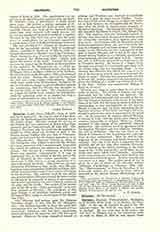

Silverius, Saint, POPE (536-37), dates of birth and death unknown. He was the son of Pope Hormisdas who had been married before becoming one of the higher clergy. Silverius entered the service of the Church and was subdeacon at Rome when Pope Agapetus died at Constantinople, April 22, 536. The Empress Theodora, who favored the Monophysites sought to bring about the election as pope of the Roman deacon Vigilius who was then at Constantinople and had given her the desired guarantees as to the Monophysites. However, Theodatus, King of the Ostrogoths, who wished to prevent the election of a pope connected with Constantinople, forestalled her, and by his influence the subdeacon Silverius was chosen. The election of a subdeacon as Bishop of Rome was unusual. Consequently, it is easy to understand that, as the author of the first part of the life of Silverius in the “Liber pontificalis” (ed. Duchesne, I, 210) relates, a strong opposition to it appeared among the clergy. This, however, was suppressed by Theodatus so that, finally, after Silverius had been consecrated bishop (probably on June 8, 536) all the Roman presbyters gave their consent in writing to his elevation. The assertion made by the author just mentioned that Silverius secured the intervention of Theodatus by payment of money is unwarranted, and is to be explained by the writer’s hostile opinion of the pope and the Goths. The author of the second part of the life in the “Liber pontificalis” is favorably inclined to Silverius. The pontificate of this pope belongs to an unsettled, disorderly period and he himself fell a victim to the intrigues of the Byzantine Court.
After Silverius had become pope the Empress Theodora sought to win him for the Monophysites. She desired especially to have him enter into communion with the Monophysite Patriarch of Constantinople, Anthimus, who had been excommunicated and deposed by Agapetus, and with Severus of Antioch. However, the pope committed himself to nothing and Theodora now resolved to overthrow him and to gain the papal see for Vigilius. Troublous times befell Rome during the struggle that broke out in Italy between the Ostrogoths and the Byzantines after the death of Amalasuntha, daughter of Theodoric the Great. The Ostrogothic king, Vitiges, who ascended the throne in August, 536, besieged the city. The churches over the catacombs outside of the city were devastated, the graves of the martyrs in the catacombs themselves were broken open and desecrated. In December, 536, the Byzantine general Belisarius garrisoned Rome and was received by the pope in a friendly and courteous manner. Theodora sought to use Belisarius for the carrying out of her plan to depose Silverius and to put in his place the Roman deacon Vigilius (q.v.), formerly apocrisary at Constantinople, who had now gone to Italy. Antonina, wife of Belisarius, influenced her husband to act as Theodora desired. By means of a forged letter the pope was accused of a treasonable agreement with the Gothic king who was besieging Rome. It was asserted that Silverius had offered the king to leave one of the city gates secretly open so as to permit the Goths to enter. Silverius was consequently arrested in March, 537, roughly stripped of his episcopal dress, given the clothing of a monk and carried off to exile in the East. Vigilius was consecrated Bishop of Rome in his stead.
Silverius was taken to Lycia where he was sent to reside at Patara. The Bishop of Patara very soon discovered that the exiled pope was innocent. He journeyed to Constantinople and was able to lay before the Emperor Justinian such proofs of the innocence of the exile that the emperor wrote to Belisarius commanding a new investigation of the matter. Should it turn out that the letter concerning the alleged plot in favor of the Goths was forged, Silverius should be placed once more in possession of the papal see. At the same time the emperor allowed Silverius to return to Italy, and the latter soon entered the country, apparently at Naples. However, Vigilius arranged to take charge of his unlawfully deposed predecessor. He evidently acted in agreement with the Empress Theodora and was aided by Antonina, the wife of Belisarius. Silverius was taken to the Island of Palmaria in the Tyrrhenian Sea and kept there in close confinement. Here he died in consequence of the privations and harsh treatment he endured. The year of his death is unknown, but he probably did not live long after reaching Palmaria. He was buried on the island, according to the testimony of the “Liber pontificalis” on June 20; his remains were never taken from Palmaria. According to the same witness he was invoked after death by the believers who visited his grave. In later times he was venerated as a saint. The earliest proof of this is given by a list of saints of the eleventh century (Melanges d’archeologie et d’histoire, 1893, 169). The “Martyrologium” of Peter de Natalibus of the fourteenth century also contains his feast, which is recorded in the present Roman Martyrology on June 20.
J. P. KIRSCH

